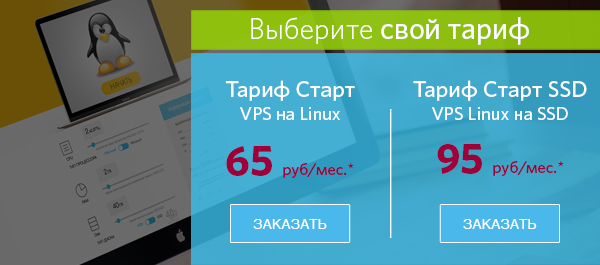Do not think about seconds down
Those who are interested in web hosting, know that today a number of providers offer hosting with the SSD (Solid State Drive) option. How much is needed for a website? What does the use of solid-state drives in comparison with traditional drives - HDD? Is the game worth the candle?

As you know, SSD drives do not contain moving parts and can read and write data much faster than HDD. SSDs are storage devices, the speed of which is much higher than that of conventional hard drives with mechanically moving read-write heads.

Progress in write density in HDD and flash memory (GB per square inch).
')
Although the linear read speed on the HDD has increased significantly in recent years, and the recording density on the plate continues to increase, the speed of movement of the read / write head changes little, so often these discs are slow. The speed of solid-state drives can be several times greater than the potential of hard drives.

Currently, 90% of hosting providers in the world use servers with HDD, as this is the cheapest option, disk drives have a large capacity, are easily configured to work with servers, do not require special hardware.
Meanwhile, according to Gartner's forecast, already in 2017, enterprise-class SSDs will be sold more than HDDs. In the next three years, in the corporate segment, SSD sales (in monetary terms) will grow by an average of 20% per year, while HDDs will increase only by 4%. In Transparency Market Research (TMR), they also believe that by 2022 the segment of enterprise-class SSD drives will develop the fastest: the average annual growth rate of sales of such products may exceed 76%.
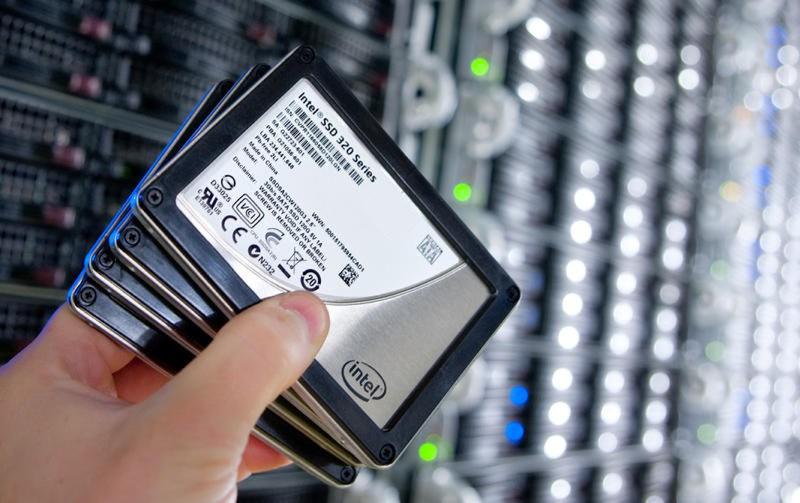
Along with the increase in speed, the SSD capacity also grows. In 2016, Seagate, Samsung, Toshiba, Western Digital, and a dozen other vendors presented a large-capacity SSD that can be used for data archiving tasks previously unusual for flash drives. Samsung plans to release a 2.5-inch flash drive with a capacity of 100 TB by 2020. Its high-capacity SSD uses 64-ply 3D V-NAND memory. The data transfer rate of a single chip with a capacity of 64 GB reaches 800 Mbps.
Samsung also introduced a BGA (Ball-Grid Array) SSD with three bits per cell. With a weight of 1 g, it holds 1 TB of data. The sequential read speed is 1500 MB / s, and the write speed is 900 MB / s. Among the other new Samsung - SSD form factor M.2 with a capacity of 2 TB.
Many SSDs are designed specifically for data centers. For example, released in August 2016, the Intel SSD DC P3520 Series are PCIe SSD devices that are optimized for high performance at a reasonable price. SSD DC P3520 series drives are suitable for working in cloud environments in applications with a large number of read operations, for example, when virtualizing storage systems or for organizing web hosting. Intel PCIe SSD solid state drives based on 3D NAND technology are becoming an affordable alternative when deploying NVMe-supported storage arrays where large data sets need to be processed.
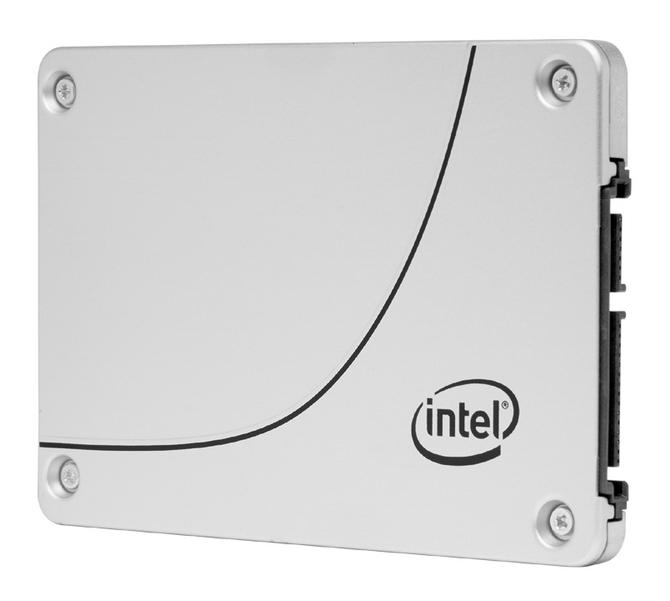
According to Intel, the solid state drives of the Intel SSD DC S3520 series provide a good combination of low cost and high performance for data centers and provide significant performance gains and reduced delays compared to traditional HDD drives used in the data center. The devices of the SSD DC S3520 series are targeted at those who wish to replace the disk drives with SSDs with SATA interface.

Equipped with flash drives, servers and storage systems today can solve the most demanding tasks, such as searching in large databases, online transaction processing, business analytics and large-scale virtualization in cloud computing.
The problem of SSD durability has been practically solved: modern drives are designed for five years of intensive use. SSD have every chance in the near future to replace the HDD in the servers, and in the future - in the storage system. Already announced SSD capacity of 16 TB, and by 2020 there will be a flash drive with a capacity of 40 TB. New developments can lead to significant changes in many segments of the IT industry.
But what does all this mean in terms of today's site hosting tasks?
In general, when using SSDs, the operating system and applications load faster, data access is faster, while HDDs have more attractive cost indicators, and it is more profitable to store large amounts of data on them. Capacity on SSD costs so far that much more expensive. Let's try to weigh the pros and cons in more detail.
Hard Drives, HDD
Flash Drives, SSD
And in specific numbers :
And here is another comparison, more visual (data may differ for different models of drives and interfaces):
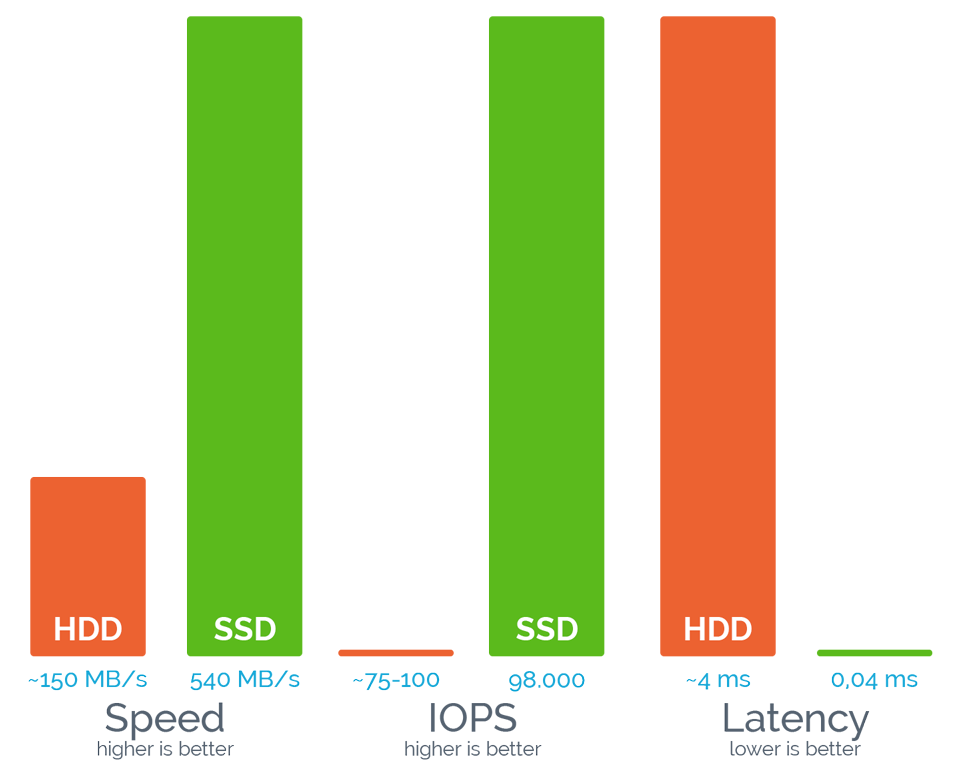
HDD vs. SSD: speed, performance, delay.
It follows that SSD is at least 15 times faster, 4-10 times more reliable than HDD. On a large server, using them will save about 100 watts of power consumption and free up 6% of the computing power. But what advantages does all this give when hosting websites?
In fact, several factors affect the loading time of a site page:
As you can see, the total load time of a page of a site depends not only on the speed of reading data, but this time is a crucial component. When a website is hosted on an SSD, it gets all the benefits of high speed access to this carrier.
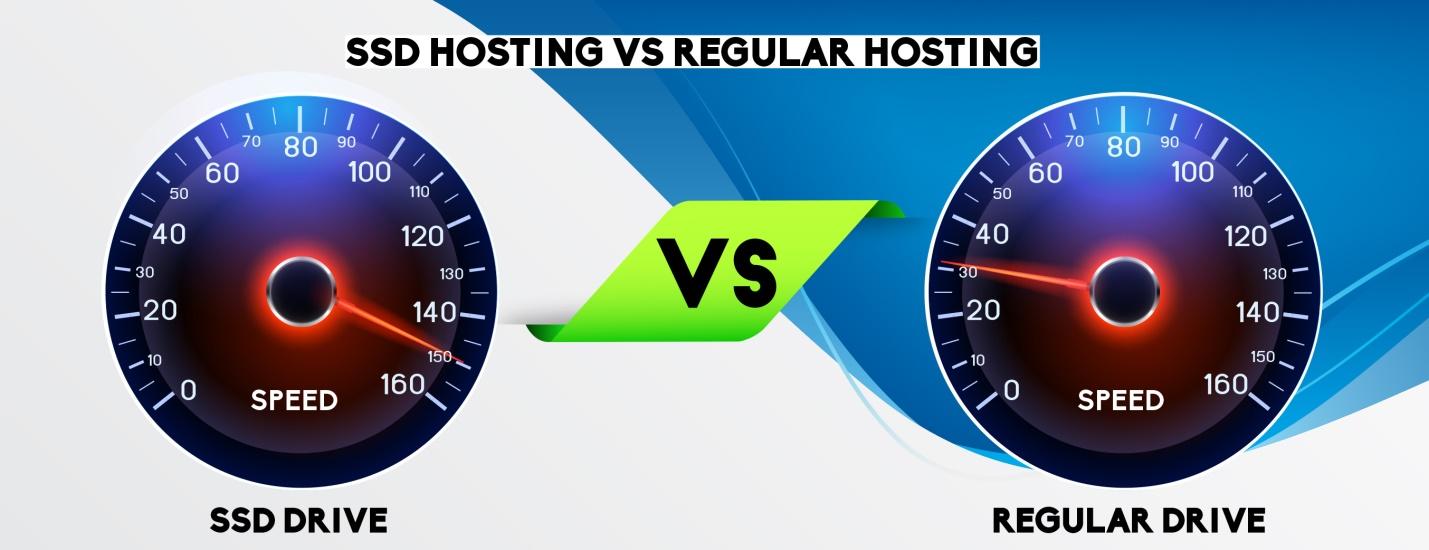
Providers often use reliable and fast enterprise-class SSDs with eMLC memory type. The disks combined in a RAID array achieve data transfer rates of up to 100,000 IOPS, and Windows VPS starts within 7 seconds.
Optimizing site performance by speeding up server data readout especially and instant work with files on the SSD is desirable for sites in the following categories:
What potential gain can SSD hosting provide? If your site works so well and the page loading speed is quite decent, do you need to switch to solid-state drives? To feel the difference, you need to experiment with SSD. Here are some of the gains promised by some foreign hosting providers:
This shows that in most cases, the load time of pages on the site due to SSD-drives is reduced three times. In fact, in each case, the gain may be different. High speed SSD-drives are most noticeable for sites with high dynamics of working with data or with heavy traffic (like social networks). The only real way to evaluate the benefits for a particular site is to try SSD in action.
Issue price
And how much is this pleasure? SSD hosting prices usually start at a few dollars a month. Let's give examples of some offers of providers:
So hosting on SSD is the right solution not only for serious projects. For 95 rubles a month, you can completely unleash a small gigabyte site for ten on the SSD. Of course, sites that require additional capacity, dedicated computing cores, bandwidth, or other services will cost more, but if high capacity is not required, then hosting on SSD is an affordable option.
Before turning to the conclusion, summarize what has been said:
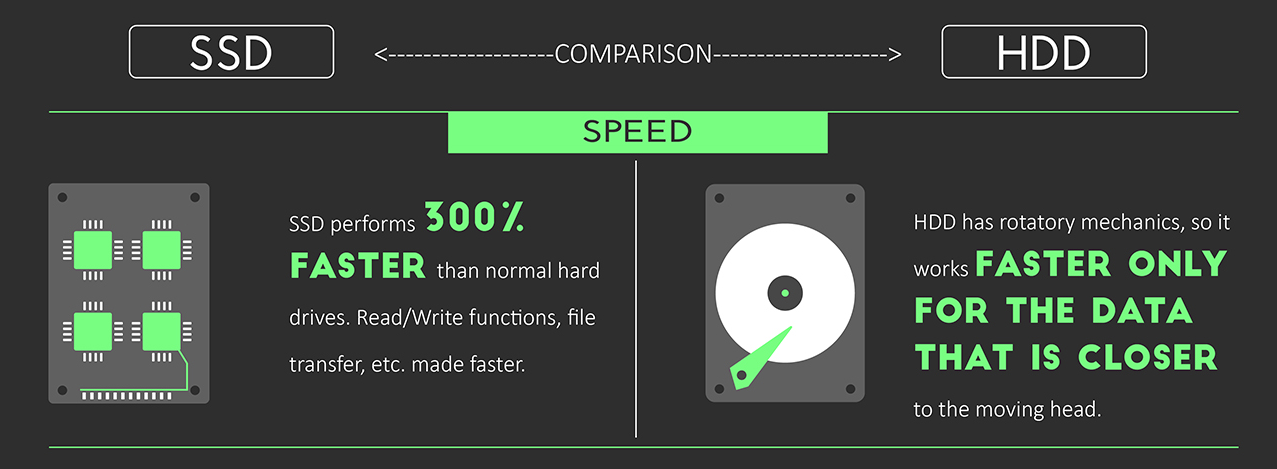
Speed. SSDs are 300% faster than HDDs, which affects read-write speeds, file transfers, etc. HDDs quickly read only data that is close to the read head.

Noise. Since SSD drives do not have moving parts, they work silently.

System load time. In the case of SSD-drives, it averages 10-13 seconds, HDD - 30-40 seconds.

Weight. SSD-drive is much easier, since it consists mainly of microcircuits.

Power usage. SSD consumes less than 2 watts even at peak load, HDD - 6-7 watts. The use of SSD-drives allows you to reduce energy consumption by 80%, they do not require significant cooling costs. If we take into account the savings in the scale of the data center, it becomes obvious prospect of using solid-state drives to reduce operating costs.

Reliability. Modern SDD drives are highly reliable, while drive failures are not uncommon.

Defragmentation. SSDs do not need it. HDD without defragmentation loses performance.

Response time. With SSD drives, it is almost a hundred times smaller than that of the HDD and is 35-100 ms versus 5000-10000.

Performance. In HDD, it is much lower than in SSD-drives, where mechanical operations are not required.

Bounce rate. Mechanics HDD fails more often. SSD drives have a very low failure rate.
Failure of the disk - the trouble for the site owner, because often all the data that are located on the hard disk, are lost (if you ignore the backup). In the case of SSD failure is usually not fatal: the "aged" drive becomes impossible, but the stored information remains available. In addition, SSDs are less susceptible to mechanical damage. Testing shows that even the cheapest models of solid-state drives with daily recording can work properly for more than 10 years.
This may be an exaggeration, but for e-commerce sites, millisecond losses can mean loss of profits. And not only for them. Even a slight improvement in the speed of the site sometimes gives tangible results: the number of visitors to the site increases, the average time to browse the site, this is reflected in financial performance. For example, for dynamic sites on HDD it can be 15-20 ms, while on SSD it is 0.2 ms.
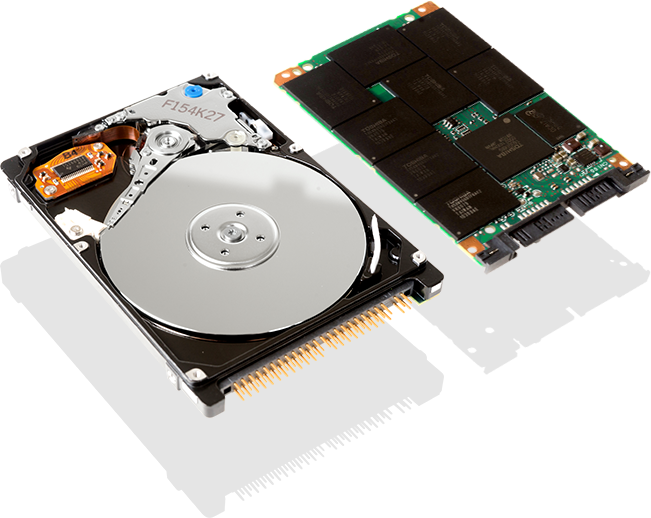
The site may lose visitors, if the pages are loaded for too long, or they will quickly leave it. According to KISSmetrics statistics, if a site loads in about 4 seconds, then up to a quarter of clients leave the page. So a small investment in hosting on SSD drives can ultimately pay for itself many times over. The faster the website loads, the more actively sales grow.
However, it is likely that SSD drives will not be the most cost-efficient choice for such tasks as web storage, large archives of video, photos or music, or other tasks that require storing large amounts of data. Yes, the video will start faster, but at a constant data transfer rate, streaming, SSD practically does not give advantages.

The general conclusion is this: it all depends on the requirements. For example, SSD hosting speeds up access to a database on a server. For many sites, this is not just a desirable indicator, but a necessary condition for their correct operation, for example, if the site is built on one of the popular CMS, then you may need to host an SSD to quickly load pages.
Fast hosting will be useful for sites that receive advertising revenue, because the profit in this case depends on the time spent by visitors to the site, as well as on the number of page views. but there is a third option.
Despite all its advantages, SSDs are still quite expensive. Some hosting providers offer hybrid hosting - on SSD in combination with SATA drives. Space on specialized servers with SSD-drives is used for the most loaded processes of the sites - for working with databases.
Combining SSD and HDD drives in one hosting plan is quite an original solution. The main amount of data in this case can be stored on capacious, but relatively slow HDD, and requests are cached on high-performance, but less capacious SSD. The caching mechanism can work as follows: when the request goes to the disk system, the availability of the requested data is checked first on the SSD (in the cache), and if they are not there, it is requested from the main one. disk storage, transferred to the client and simultaneously cached.
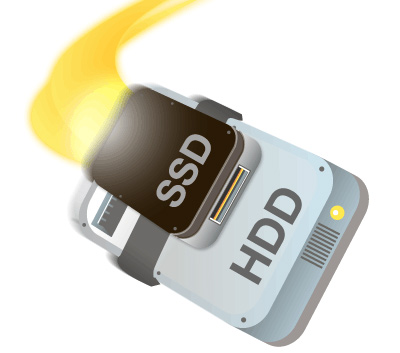
This is similar to using the built-in cache memory, a disk drive, but the SSD cache capacity is much more, and it does not work more efficiently. The main advantage of this approach is the rational use of the capabilities of the two technologies - high performance SSD and high capacity HDD (at low storage cost) without significant loss of performance. Of course, this is a compromise option.
As a rule, a server only on SSDs will work faster, although promotional offers often promise that when hosting with caching on SSD drives, the speed will be just as high at a lower price and with higher capacity.
Again, it all depends on the task, on how the virtual server will be used. If this is a dynamic project with a large number of requests (visited site, 1C base, game server), then the combination of SSD-HDD will be significantly inferior to SSD in speed of work. If, on the server, they are mostly not very “active” and are rarely requested, then the speed when hosting with caching on the SSD can be close to the “pure” SSD hosting. HDD is better to use in the case when the access speed does not play a fundamental role, for example, in small projects, archival storage, etc.

As you know, SSD drives do not contain moving parts and can read and write data much faster than HDD. SSDs are storage devices, the speed of which is much higher than that of conventional hard drives with mechanically moving read-write heads.
"Rules of the game" are changing

Progress in write density in HDD and flash memory (GB per square inch).
')
Although the linear read speed on the HDD has increased significantly in recent years, and the recording density on the plate continues to increase, the speed of movement of the read / write head changes little, so often these discs are slow. The speed of solid-state drives can be several times greater than the potential of hard drives.

Currently, 90% of hosting providers in the world use servers with HDD, as this is the cheapest option, disk drives have a large capacity, are easily configured to work with servers, do not require special hardware.
Meanwhile, according to Gartner's forecast, already in 2017, enterprise-class SSDs will be sold more than HDDs. In the next three years, in the corporate segment, SSD sales (in monetary terms) will grow by an average of 20% per year, while HDDs will increase only by 4%. In Transparency Market Research (TMR), they also believe that by 2022 the segment of enterprise-class SSD drives will develop the fastest: the average annual growth rate of sales of such products may exceed 76%.

Along with the increase in speed, the SSD capacity also grows. In 2016, Seagate, Samsung, Toshiba, Western Digital, and a dozen other vendors presented a large-capacity SSD that can be used for data archiving tasks previously unusual for flash drives. Samsung plans to release a 2.5-inch flash drive with a capacity of 100 TB by 2020. Its high-capacity SSD uses 64-ply 3D V-NAND memory. The data transfer rate of a single chip with a capacity of 64 GB reaches 800 Mbps.
Samsung also introduced a BGA (Ball-Grid Array) SSD with three bits per cell. With a weight of 1 g, it holds 1 TB of data. The sequential read speed is 1500 MB / s, and the write speed is 900 MB / s. Among the other new Samsung - SSD form factor M.2 with a capacity of 2 TB.
Many SSDs are designed specifically for data centers. For example, released in August 2016, the Intel SSD DC P3520 Series are PCIe SSD devices that are optimized for high performance at a reasonable price. SSD DC P3520 series drives are suitable for working in cloud environments in applications with a large number of read operations, for example, when virtualizing storage systems or for organizing web hosting. Intel PCIe SSD solid state drives based on 3D NAND technology are becoming an affordable alternative when deploying NVMe-supported storage arrays where large data sets need to be processed.

According to Intel, the solid state drives of the Intel SSD DC S3520 series provide a good combination of low cost and high performance for data centers and provide significant performance gains and reduced delays compared to traditional HDD drives used in the data center. The devices of the SSD DC S3520 series are targeted at those who wish to replace the disk drives with SSDs with SATA interface.

Equipped with flash drives, servers and storage systems today can solve the most demanding tasks, such as searching in large databases, online transaction processing, business analytics and large-scale virtualization in cloud computing.
The problem of SSD durability has been practically solved: modern drives are designed for five years of intensive use. SSD have every chance in the near future to replace the HDD in the servers, and in the future - in the storage system. Already announced SSD capacity of 16 TB, and by 2020 there will be a flash drive with a capacity of 40 TB. New developments can lead to significant changes in many segments of the IT industry.
But what does all this mean in terms of today's site hosting tasks?
SSD: Pros and Cons
In general, when using SSDs, the operating system and applications load faster, data access is faster, while HDDs have more attractive cost indicators, and it is more profitable to store large amounts of data on them. Capacity on SSD costs so far that much more expensive. Let's try to weigh the pros and cons in more detail.
Hard Drives, HDD
| Behind | Vs |
| Low storage cost per gigabyte | Slow search, low read and write speeds |
| Large capacity (up to 8 TB per disk) | Disc failures are not uncommon |
| Performance can be increased with RAID | Simultaneous read and write operations are not possible. |
Flash Drives, SSD
| Behind | Vs |
| Fast search, high read and write speeds | Relatively high storage cost per gigabyte |
| Simultaneous read and write operations are possible. | Limited number of write operations (media wear) |
| Higher energy efficiency than HDD | Less available capacity |
And in specific numbers :
| Parameter | SSD | HDD (SAS, 10-15k) |
| Random Access I / O Performance (IOPS) | 6000 | 400 |
| Reliability (failure rate) | 0.5% | 2-5% |
| power usage | 2-5 W | 6-15 W |
| I / O waiting time | 4 ms | 7 ms |
| Access time | 0.1 ms | 5.5-8 ms |
| Average I / O request processing time during backup | 20 ms | 400-500 ms |
| Estimated Drive Backup Time | 6 h | 20-24h |
And here is another comparison, more visual (data may differ for different models of drives and interfaces):

HDD vs. SSD: speed, performance, delay.
It follows that SSD is at least 15 times faster, 4-10 times more reliable than HDD. On a large server, using them will save about 100 watts of power consumption and free up 6% of the computing power. But what advantages does all this give when hosting websites?
Website: Download Time
In fact, several factors affect the loading time of a site page:
- The domain name server (DNS) on the textual name of the site assigns an IP address (DNS Lookup).
- When the site's host server receives an HTTP GET request from the client, it needs to read the necessary data from the storage system, process it, and send the information to the client.
- The client-side browser interprets and displays the information received.
As you can see, the total load time of a page of a site depends not only on the speed of reading data, but this time is a crucial component. When a website is hosted on an SSD, it gets all the benefits of high speed access to this carrier.

Providers often use reliable and fast enterprise-class SSDs with eMLC memory type. The disks combined in a RAID array achieve data transfer rates of up to 100,000 IOPS, and Windows VPS starts within 7 seconds.
Optimizing site performance by speeding up server data readout especially and instant work with files on the SSD is desirable for sites in the following categories:
- E-commerce site or online store.
- Web applications (work applications, games, media players).
- Popular blogs and news feeds with high traffic.
- Corporate sites.
- Other valuable online resources.
What potential gain can SSD hosting provide? If your site works so well and the page loading speed is quite decent, do you need to switch to solid-state drives? To feel the difference, you need to experiment with SSD. Here are some of the gains promised by some foreign hosting providers:
| Hosting | Declared speed gain when using SSD |
| Monstermegs | Page load time improves up to 300%. |
| Inmotion Hosting | With intensive I / O requests, data access time is reduced by 20 times. |
| A2 Hosting | Pages load up to 300% faster. |
| Crocweb | Performance in IOPS is up to 100%. |
| Asura hosting | Acceleration of loading pages up to 300%. |
| Wire nine | Increase productivity up to 300%. |
This shows that in most cases, the load time of pages on the site due to SSD-drives is reduced three times. In fact, in each case, the gain may be different. High speed SSD-drives are most noticeable for sites with high dynamics of working with data or with heavy traffic (like social networks). The only real way to evaluate the benefits for a particular site is to try SSD in action.
Issue price
And how much is this pleasure? SSD hosting prices usually start at a few dollars a month. Let's give examples of some offers of providers:
| Hosting | Starting price (dollars per month) | Capacity (GB) |
| Monstermegs | 5.95 | ten |
| Inmotion Hosting | 4.19 | Not specified |
| A2 Hosting | 3.62 | RAID-10 without restrictions (not the fact that everything is on SSD) |
| Crocweb | 4.95 | ten |
| Asura hosting | one | 3 |
| Wire nine | 25 | 15 |
| RUVDS (Russia) | 1.5 | ten |
So hosting on SSD is the right solution not only for serious projects. For 95 rubles a month, you can completely unleash a small gigabyte site for ten on the SSD. Of course, sites that require additional capacity, dedicated computing cores, bandwidth, or other services will cost more, but if high capacity is not required, then hosting on SSD is an affordable option.
SSD vs HDD
Before turning to the conclusion, summarize what has been said:

Speed. SSDs are 300% faster than HDDs, which affects read-write speeds, file transfers, etc. HDDs quickly read only data that is close to the read head.

Noise. Since SSD drives do not have moving parts, they work silently.

System load time. In the case of SSD-drives, it averages 10-13 seconds, HDD - 30-40 seconds.

Weight. SSD-drive is much easier, since it consists mainly of microcircuits.

Power usage. SSD consumes less than 2 watts even at peak load, HDD - 6-7 watts. The use of SSD-drives allows you to reduce energy consumption by 80%, they do not require significant cooling costs. If we take into account the savings in the scale of the data center, it becomes obvious prospect of using solid-state drives to reduce operating costs.

Reliability. Modern SDD drives are highly reliable, while drive failures are not uncommon.

Defragmentation. SSDs do not need it. HDD without defragmentation loses performance.

Response time. With SSD drives, it is almost a hundred times smaller than that of the HDD and is 35-100 ms versus 5000-10000.

Performance. In HDD, it is much lower than in SSD-drives, where mechanical operations are not required.

Bounce rate. Mechanics HDD fails more often. SSD drives have a very low failure rate.
Failure of the disk - the trouble for the site owner, because often all the data that are located on the hard disk, are lost (if you ignore the backup). In the case of SSD failure is usually not fatal: the "aged" drive becomes impossible, but the stored information remains available. In addition, SSDs are less susceptible to mechanical damage. Testing shows that even the cheapest models of solid-state drives with daily recording can work properly for more than 10 years.
Time is money
This may be an exaggeration, but for e-commerce sites, millisecond losses can mean loss of profits. And not only for them. Even a slight improvement in the speed of the site sometimes gives tangible results: the number of visitors to the site increases, the average time to browse the site, this is reflected in financial performance. For example, for dynamic sites on HDD it can be 15-20 ms, while on SSD it is 0.2 ms.

The site may lose visitors, if the pages are loaded for too long, or they will quickly leave it. According to KISSmetrics statistics, if a site loads in about 4 seconds, then up to a quarter of clients leave the page. So a small investment in hosting on SSD drives can ultimately pay for itself many times over. The faster the website loads, the more actively sales grow.
However, it is likely that SSD drives will not be the most cost-efficient choice for such tasks as web storage, large archives of video, photos or music, or other tasks that require storing large amounts of data. Yes, the video will start faster, but at a constant data transfer rate, streaming, SSD practically does not give advantages.

The general conclusion is this: it all depends on the requirements. For example, SSD hosting speeds up access to a database on a server. For many sites, this is not just a desirable indicator, but a necessary condition for their correct operation, for example, if the site is built on one of the popular CMS, then you may need to host an SSD to quickly load pages.
Fast hosting will be useful for sites that receive advertising revenue, because the profit in this case depends on the time spent by visitors to the site, as well as on the number of page views. but there is a third option.
SSD + HDD
Despite all its advantages, SSDs are still quite expensive. Some hosting providers offer hybrid hosting - on SSD in combination with SATA drives. Space on specialized servers with SSD-drives is used for the most loaded processes of the sites - for working with databases.
Combining SSD and HDD drives in one hosting plan is quite an original solution. The main amount of data in this case can be stored on capacious, but relatively slow HDD, and requests are cached on high-performance, but less capacious SSD. The caching mechanism can work as follows: when the request goes to the disk system, the availability of the requested data is checked first on the SSD (in the cache), and if they are not there, it is requested from the main one. disk storage, transferred to the client and simultaneously cached.

This is similar to using the built-in cache memory, a disk drive, but the SSD cache capacity is much more, and it does not work more efficiently. The main advantage of this approach is the rational use of the capabilities of the two technologies - high performance SSD and high capacity HDD (at low storage cost) without significant loss of performance. Of course, this is a compromise option.
As a rule, a server only on SSDs will work faster, although promotional offers often promise that when hosting with caching on SSD drives, the speed will be just as high at a lower price and with higher capacity.
Again, it all depends on the task, on how the virtual server will be used. If this is a dynamic project with a large number of requests (visited site, 1C base, game server), then the combination of SSD-HDD will be significantly inferior to SSD in speed of work. If, on the server, they are mostly not very “active” and are rarely requested, then the speed when hosting with caching on the SSD can be close to the “pure” SSD hosting. HDD is better to use in the case when the access speed does not play a fundamental role, for example, in small projects, archival storage, etc.
Source: https://habr.com/ru/post/312288/
All Articles
